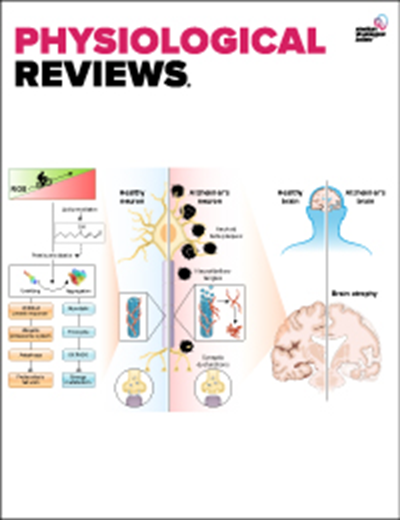健康和帕金森病患者的线粒体质量控制。
IF 29.9
1区 医学
Q1 PHYSIOLOGY
引用次数: 45
摘要
作为细胞代谢和细胞内信号传导的中枢,线粒体是一个关键的细胞器,其功能障碍与包括神经退行性疾病,特别是帕金森病在内的几种人类疾病有关。线粒体面临的一个内在挑战是持续暴露于各种压力下,这增加了它们失调的可能性。作为回应,真核细胞已经进化出复杂的质量控制机制来监测、识别、修复和/或消除线粒体内异常或错误折叠的蛋白质和/或功能失调的线粒体本身。伴侣蛋白可以识别线粒体蛋白中不稳定或异常的构象,并可以促进其重新折叠以恢复其正确的构象和稳定性。然而,如果修复是不可能的,异常蛋白被选择性地降解,以防止潜在的破坏性相互作用与其他蛋白质或其寡聚化成有毒的多聚体复合物。自噬-溶酶体系统和泛素-蛋白酶体系统介导这种异常或错误折叠的蛋白质物种的选择性和靶向降解。线粒体自噬(一种特殊的自噬)通过选择性清除功能失调的线粒体,以防止细胞内功能失调的细胞器受到有害影响。尽管我们对功能失调线粒体的分子反应了解越来越多,但许多关键方面仍然知之甚少。在此,我们回顾了线粒体质量控制的新兴机制,包括与线粒体输入机制耦合的质量控制策略。此外,我们回顾了调节线粒体自噬的分子机制,重点关注细胞生理学和帕金森病细胞生物学背景下PINK1/ Parkinson介导的线粒体自噬的调节。本文章由计算机程序翻译,如有差异,请以英文原文为准。
Mitochondrial quality control in health and in Parkinson's disease.
As a central hub for cellular metabolism and intracellular signalling, the mitochondrion is a pivotal organelle, dysfunction of which has been linked to several human diseases including neurodegenerative disorders, and in particular Parkinson's disease. An inherent challenge that mitochondria face is the continuous exposure to diverse stresses which increase their likelihood of dysregulation. In response, eukaryotic cells have evolved sophisticated quality control mechanisms to monitor, identify, repair and/or eliminate abnormal or misfolded proteins within the mitochondrion and/or the dysfunctional mitochondrion itself. Chaperones identify unstable or otherwise abnormal conformations in mitochondrial proteins and can promote their refolding to recover their correct conformation and stability. However, if repair is not possible, the abnormal protein is selectively degraded to prevent potentially damaging interactions with other proteins or its oligomerization into toxic multimeric complexes. The autophagic-lysosomal system and the ubiquitin-proteasome system mediate the selective and targeted degradation of such abnormal or misfolded protein species. Mitophagy (a specific kind of autophagy) mediates the selective elimination of dysfunctional mitochondria, in order to prevent the deleterious effects the dysfunctional organelles within the cell. Despite our increasing understanding of the molecular responses toward dysfunctional mitochondria, many key aspects remain relatively poorly understood. Herein, we review the emerging mechanisms of mitochondrial quality control including quality control strategies coupled to mitochondrial import mechanisms. In addition, we review the molecular mechanisms regulating mitophagy with an emphasis on the regulation of PINK1/PARKIN-mediated mitophagy in cellular physiology and in the context of Parkinson's disease cell biology.
求助全文
通过发布文献求助,成功后即可免费获取论文全文。
去求助
来源期刊

Physiological reviews
医学-生理学
CiteScore
56.50
自引率
0.90%
发文量
53
期刊介绍:
Physiological Reviews is a highly regarded journal that covers timely issues in physiological and biomedical sciences. It is targeted towards physiologists, neuroscientists, cell biologists, biophysicists, and clinicians with a special interest in pathophysiology. The journal has an ISSN of 0031-9333 for print and 1522-1210 for online versions. It has a unique publishing frequency where articles are published individually, but regular quarterly issues are also released in January, April, July, and October. The articles in this journal provide state-of-the-art and comprehensive coverage of various topics. They are valuable for teaching and research purposes as they offer interesting and clearly written updates on important new developments. Physiological Reviews holds a prominent position in the scientific community and consistently ranks as the most impactful journal in the field of physiology.
 求助内容:
求助内容: 应助结果提醒方式:
应助结果提醒方式:


